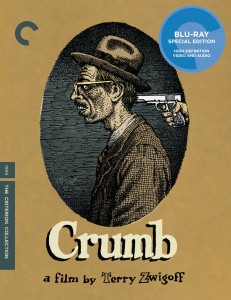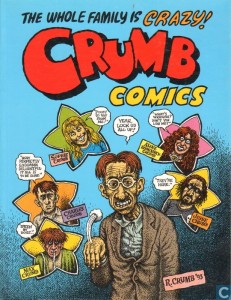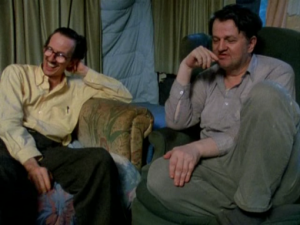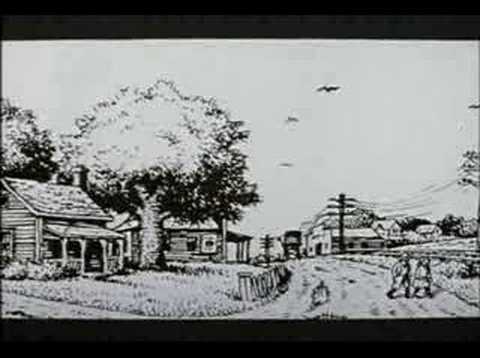Written in 2010 for Criterion’s DVD and Blu-Ray. This is the second of my essays about Terry Zwigoff’s documentary; for the first one, written 15 years earlier, go here. — J.R.
Now that Terry Zwigoff’s Crumb is about fifteen years old, it seems pretty safe to say that it has evolved from being a potential classic to actually becoming one. But what kind? A documentary portrait of a comic-book artist, musician, and nerdy outsider? A personal film essay? A cultural study? An account of family dysfunction and sexual obsession? Or maybe just a meditation on what it means to be an American male artist — specifically, one so traumatized by his adolescence that he has never found a way of fully growing past it.
In fact, Crumb is all these things, with a generous amount of thoughtful art criticism thrown in as well. An old friend of Robert Crumb’s, Terry Zwigoff shot the movie over six years and edited it over three, and the multifaceted density and sometimes disturbing nature of what he has to show and say over two hours seems partly a function of the amount of time he had to mull it over. It’s worth adding that he was in therapy for part of that time, which surely had an impact on the film’s searching thoughtfulness and on Zwigoff’s own investment in the material. It’s a truthful film and a troubling one, and the highly skillful way in which it’s structured and focused — oscillating between different periods in Crumb’s life, from East Coast to West Coast, from biography to commentary, among family, colleagues, and critics — which Zwigoff says producer Lynn O’Donnell helped him to achieve, has a great deal to do with its success. The creation of such a complex weave, while proceeding so logically and fluidly, without any sense of shifting gears, is one of its outstanding achievements.
Zwigoff was a member of Crumb’s short-lived blues band, the Cheap Suit Serenaders, and a fellow collector of rare twenties and thirties blues and jazz records. Prior to Crumb, he made documentaries on musical subjects — blues artist Howard Armstrong in Louie Bluie (1985) and a history of Hawaiian music in A Family Named Moe (a film so obscure that I haven’t even been able to find a date for it). And since Crumb, he’s made only fiction films, working with comic-book writer Daniel Clowes on Ghost World (2001) and Art School Confidential (2006) and directing Billy Bob Thornton in Bad Santa (2003). So Crumb stands apart from his other work, and from most other documentaries about artists as well. Clearly, Zwigoff sees Crumb as a full-fledged artist, not just as a comic-book artist, and his complicated, multivalent approach to his subject has all the elegance of three-dimensional chess.
Best of all, he doesn’t avoid or shortchange any of the moral and political issues that Crumb’s work raises, including those involving sexism and racism, although he doesn’t pretend to settle any of them either. Such commentators as Deirdre English (former editor of Mother Jones), Robert Hughes (onetime art critic for Time), cartoonist Trina Robbins, and even R. Crumb himself are invited to reflect at some length on what’s most questionable about the work, and plainly their own biases are front and center. (Hughes, for instance, has a fine time countering various PC arguments, as he does in his book The Culture of Complaint.)
***
One way of measuring the film’s sizable impact on Crumb’s own profile would be to note that in my original review of the film in the Chicago Reader, I immediately followed my uncontroversial claim that Robert Crumb was “America’s greatest underground comic-book artist” with the only slightly more refutable observation that he was “little known to most people born much before or after 1943, the year of his birth, because he’s shunned the mainstream as a money-grubbing swamp.” Maybe I was exaggerating a little about Crumb’s relative obscurity — having been born the same year as him, I could have been feeling my age — but not by much. I haven’t seen any indications that Crumb’s view of the American mainstream has changed one iota since then, but his renown within that mainstream has subsequently mushroomed to the point where some of my younger readers might question whether my second assertion could have ever been true.
The effect of Zwigoff’s film was immediate. Seven months after Crumb premiered at the Toronto Film Festival, and three months after it won the Grand Jury Prize at the Sundance Festival, the New Yorker ran a two-page comic strip in its April 24, 1995, issue heralding its commercial release, a color spread that it introduced as follows, after the headline “Comic Stripped”: “R. Crumb, the best known and knottiest of the underground ‘comix’ artists — the critic Robert Hughes calls him ‘the Brueghel of the last half of the twentieth century’ — is about to become more aboveground than anyone might have dreamed, or hallucinated, and a lot more notorious than he cares to be.”
Then, in the strip itself (“Head for the Hills! Trying to Escape the ‘R. Crumb Thing’ with Aline ’n’ Bob”), a “graphic colloquy” in which Crumb and his wife, the artist Aline Kominsky-Crumb, “tell how they feel about it,” with each artist drawing his or her own character, the couple duly recording their ambivalent responses to catching up with Crumb on video. Nine panels after Crumb tosses his trademark hat into a ravine (“One thing is certain . . . I’m gonna have to change my appearance!”), Aline remarks, “I just read in Newsweek that the Academy Awards judges turned off Crumb after 25 minutes,” and Bob, looking even more seedy, grizzled, and cadaverous than usual, replies, “Yeah? Good! If they’d loved it can you imagine the hell our lives would become?”
This strip, incidentally, is the final item in a 1998 book that has already become a bit of a collector’s item, Crumb Comics: The Whole Family Is Crazy! Based on an idea by Zwigoff, who contributed an introduction and afterword, and edited by Robert’s younger brother, Maxon, it offers many fascinating appendices to Crumb: art and writings by their doomed older brother, Charles (including even all twelve pages of Charles’s Famous Artists Talent Test, some of which is shown in the film), as well as by Robert, Maxon, Aline, and Robert’s two children by separate marriages, Jesse and Sophie. It’s a collection that helps to clarify the fact that even though Crumb gives us an impression of satisfying completeness about the man and his art, it’s by design a highly selective and slanted work. As Zwigoff writes in his afterword, “People don’t seem to understand that Crumb is a very subjective film — I’ve always been very open about this fact. What the film reveals about me is as much a part of the equation as what the film reveals about Robert.” (Needless to say, the parts of the film “about” Zwigoff are much more implicit than the parts about Crumb, so we can only guess about what some of these are.) He also points out that he and Crumb have remained “best friends” and that Crumb actually regards the film highly, despite all the unwelcome attention it has brought him — assertions that are well supported by Crumb’s own interviews (although in one of those, cited by Zwigoff, Crumb’s ambivalence also comes through: “The film got more reviews and write-ups and articles in the space of a year than my own comic work had gotten since I first became a known artist in 1968!”).
***
One of the first things we hear in the film is Crumb saying, “If I don’t draw for awhile, I get really crazy, depressed, and suicidal,” and it doesn’t take long for him to bring up his older brother, Charles, perhaps his major artistic influence, as a sobering counterexample. (The film doesn’t have as much to say about his extrafamilial influences, which range from Brueghel to Hogarth to Harvey Kurtzman, and might even include the comparably troubled and sexually obsessed Al Capp, although the latter’s name curiously never seems to come up in Crumb’s countless interviews.) Along with the similarly disturbed Maxon, all three boys grew up with a violently aggressive father and a more indulgent mother who was addicted to amphetamines. In order to escape from their parents, who frequently fought, and from the many social traumas they encountered at school, the brothers created their own shared and distinctive world of personalized comic books, which allowed their various sexual obsessions free reign, and we see the tragic as well as some of the more fruitful consequences of this twisted legacy over the remainder of the film. Some of the emphasis is on the positive side — and Zwigoff does a superb job of presenting Crumb’s art to us, in graphic and narrative terms. But one feels the darker implications lurking throughout the story he has to tell, most forcibly in the nervous laughter of both complicity and disbelief that emerges whenever the brothers converse with one another.
One of the most telling aspects of R. Crumb’s art is its nostalgia for the same sort of older America that his music celebrates, epitomized also in the old-fashioned bow ties and hats he often wears. His grossly stereotypical characters are merely one aspect of a world that we recognize from old ads, animated cartoons, and furniture displays—an archetypal American landscape, strictly working-class, urban, and comfortably squalid, populated by a community of goofy amblers and dim-witted wiseasses and layabouts. Strangely superimposed on this quaint, idyllic world, this warm and wistful view of the 1920s through 1950s — and yet oddly coexisting with it — is a surreal and highly satirical view of the present, with enormous quantities of lust, cruelty, violence, fear, resentment, loneliness, anxiety, and spiritual desperation. Conjuring up a jostling street life and unglamorous domestic scenes of adolescent epithets, infantile games, and various adult concerns, Crumb’s vision fully justifies Hughes’s calling him a late twentieth-century Brueghel who offers us “lusting, suffering, crazed humanity in all sorts of bizarre, gargoylelike allegorical forms” — even though it’s the early twentieth century, from an American perspective, that provides most of the scenic backgrounds.
Sadly, since moving with his family to France in the early 1990s, Crumb has had to abandon most of this world, but it seems that the move may have been a psychic necessity. For someone who has relentlessly used himself and his own life as his principal subject, he may have finally used himself up — which helps to explain why he has lately moved on to such projects as illustrating Kafka’s life and work, and the book of Genesis. Choosing between art and life is, in fact, one of the key issues that Zwigoff implicitly addresses, and as with the moral and political questions, it’s entirely to his credit that he leaves it unresolved.





